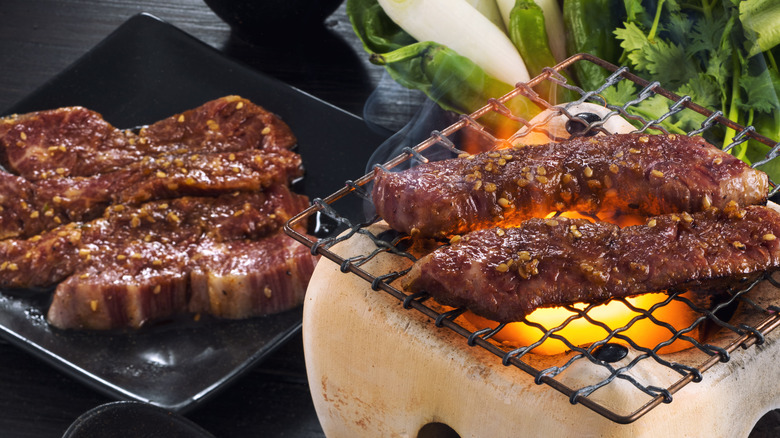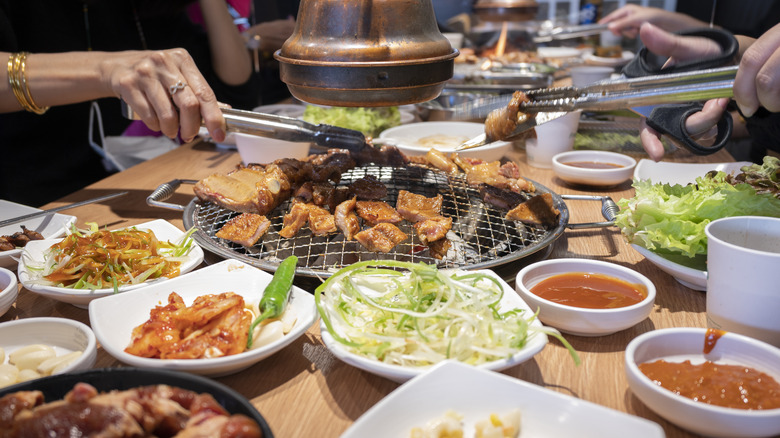The Differences Between Bulgogi And Kalbi, 2 Popular Korean Dishes
When it comes to Korean cuisine, bulgogi and kalbi (also known as galbi) are two of the most popular grilled dishes falling under the category of gui. While both are marinated and cooked over fire — whether on a grill, wok, or large skillet — the main difference lies in the cut and type of meat used. "Galbi" literally translates to "rib" in Korean, and, as the name suggests, this dish is typically made with bone-in beef short ribs.
In Southern California, the ribs are often cut across the bone, which leaves small, flat attached pieces. However, in traditional Korean preparation, the meat is cut alongside the rib bone. This results in thicker, chunkier pieces perfect for gnawing. Bulgogi, on the other hand, translates to "fire meat" and is most commonly made with ribeye that's thinly-sliced (so thin it's almost shaved). Though grilling is the most popular method, both kalbi and bulgogi can be prepared in other traditional ways, such as galbijjim and bulgogijjim, which are braised dishes using different cuts of beef cooked in a seasoned broth (-jjim refers to the cooking method of steaming or boiling.
Both dishes are staples of Korean BBQ that are typically served along with the indulgent smorgasbord known as a banchan spread: a selection of small side dishes like kimchi, blanched or pickled vegetables, and steamed egg. These are not appetizers but are enjoyed throughout the meal, each offering distinct flavors and textures that make them must-try experiences for any food lover.
Tracing bulgogi and kalbi back to two dynasties
Bulgogi can trace its roots back to the Goguryeo Dynasty (37 BC – 668 AD), where the nomadic Maek tribe enjoyed a simple dish called maekjeok — skewered meat cooked over an open fire. Over centuries, maekjeok evolved into bulgogi, a sweet and salty marinated dish that has become a beloved centerpiece of Korean BBQ today.
Kalbi or galbi, on the other hand, originated during the Goryeo Dynasty (918–1392) and has a royal connection through a dish called tteokgalbi. According to legend, while everyone enjoyed the ribs, the king needed to maintain an elegant posture and couldn't be seen tearing meat off the bone. To accommodate this, royal chefs minced the meat and molded it back onto the bone, which allowed the king to eat it gracefully with chopsticks.
While both dishes have traversed the course of Korean history across many dynasties, they made their way to the U.S. by migration after 1965. In Los Angeles, the Korean community even developed a signature take on kalbi called L.A. galbi. This evolution of kalbi reflects how traditional dishes adapt and grow as they spread across cultures and regions.
How to serve bulgogi and kalbi
To prepare these grilled meats, first you'll want to marinate them. The marinades for both bulgogi and galbi are similar, with differences mainly in portions and specific ingredients (like the addition of Korean pear puree for galbi). Both marinades feature a savory blend of soy sauce, cooking wine, brown sugar, garlic, ginger, and sesame oil. If you have a hot grill plate (or wok), you can easily recreate the Korean BBQ experience at home. Just be sure to keep a window open, as it can get smoky!
To capture the authentic experience, it's essential to have ssamjang (a savory dipping sauce made from fermented soybeans), or a simpler sauce of sesame oil, salt, and pepper. In most restaurants, bulgogi and kalbi are served together, though kalbi is usually priced higher due to the meat cost. Because it's boneless, bulgogi is ideal for making lettuce wraps: Take a leaf of lettuce (or perilla), add some rice, a bit of bulgogi, a drizzle of ssamjang, and top it off with kimchi. Kalbi, on the other hand, is typically eaten right off the bone. For a refreshing contrast, pair it with pickled radish.
While the meat takes center stage, the banchan side dishes are more than just supporting characters — they serve as palate cleansers that balance the bold flavors of the meat. The beauty of banchan is that pairings are completely customizable, and each combination enhances the overall dining experience in a unique and personal way.



